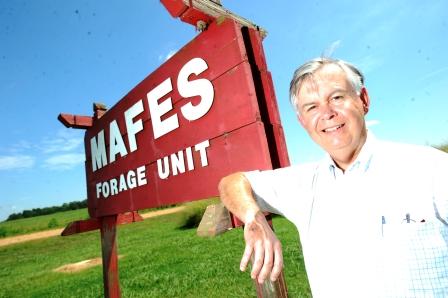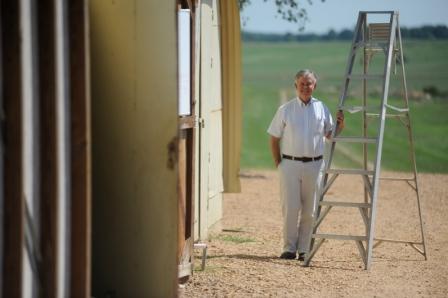STARKVILLE – When David Lang decided to patch his roof during halftime of the 2011 Gator Bowl, Mississippi State was well on its way to trouncing the University of Michigan 52 to 14.
It was an unforgettable game, alright, but the MSU scientist can’t remember a single play. Memories of that New Year’s Day – and the 10 days after – were wiped away by a brain-rattling fall that he also can’t recall.
“I still have no memory of getting the ladder,” said the associate professor for the MSU Department of Plant and Soil Science. “I’d like to use it as a teachable moment … but I can’t reproduce what I did wrong.”
Lang now thinks of himself as “a good poster person” for ladder safety. But he also has become a symbol of hope through Methodist Rehabilitation Center’s Now I Can campaign. The Jackson hospital shares Lang’s amazing recovery from a severe brain injury on its website (www.methodistonline.org/nowican/) and in the latest edition of its magazine, Ways & Means.
“Professor Lang has returned to the classroom and his research and that’s an inspiring story to the newly injured,” said Mark Adams, chief executive officer of Methodist Rehab. “His experience also helps us remind people to be cautious while using ladders. We see a number of ladder-related injuries each year, and they can be quite debilitating.”
Because it had rained on New Year’s Eve, Lang figures his downfall was a slippery rung.
“I was putting away Christmas ornaments in our family room, and I just heard a little scraping noise,” said his wife, Maureen. “I looked out and saw he had a foot on the ladder rung, and his head was on the deck. If I had been in any other room of the house, I would not have heard him. And I think he would not have made it.”
Fortunately, a rescue squad was just a block away, and Lang was quickly taken to Oktibbeha County Hospital. Physicians there stabilized Lang and sent him to the University of Mississippi Medical Center in Jackson via helicopter (another big moment he wishes he could remember).
Today, life at the Langs’ house is mostly back to normal. But the couple won’t soon forget the frightening first days of 2011. “He was in critical condition, and they were not very positive to me about how he was doing,” Maureen said. “When you ask questions and they don’t say much, you know that is a bad sign.”
The fall fractured the thickest part of Lang’s rib cage, which signaled he had hit the deck with incredible force. While his skull held up to the blow, bruising and bleeding in his brain left him susceptible to potentially deadly swelling.
“The first night in the trauma center, I felt like God said to me: You may have to give him up,” Maureen said. “As much as I didn’t want to be a widow, I put my trust in God. I really do feel he healed him. He put him in a cocoon.”
As Lang began showing signs of improvement, Maureen said she prayed for God to lead her to the best rehabilitation hospital for his needs. Soon after, word came that Lang had been accepted to Methodist Rehab’s inpatient brain injury rehabilitation program. And the couple was happy to learn that Maureen would be able to stay by her husband’s side throughout his stay.
“It’s wonderful that Methodist is family oriented like that,” Lang said. “It was definitely the right place,” Maureen said. “Daily you saw that the staff knew what to do and when to do it. They were also very sensitive to his needs, and they really listened to him.”
Like many people who have suffered brain injuries, Lang had problems with memory, mood, balance, speech, mobility and strength. “When he first came to Methodist, they sat him on the bed and he rolled right over – he was just so weak,” Maureen said.
He also suffered from double vision. He wore a patch over one eye until the end of June, and he still has some issues with his eyesight. But days filled with speech, occupational, physical and respiratory therapy helped him reclaim other abilities more quickly.
“Initially, I had been told it would be at least a semester until he could think at all,” Maureen said. “Once we came over to Methodist, I felt a lot more hopeful. As soon as he started speaking again, he started using very sophisticated language.
After Lang returned home, Clea Evans, director of Methodist Rehab’s neuropsychology department, worked with the veteran educator to foster a smooth transition back to work.
“I coordinated a specialized plan based on follow-up evaluations that helped determine his readiness,” she said. “At first, I specified that he not have any teaching responsibilities and that he just get back in the office to check emails, talk with his colleagues and look at his research.”
By June, Lang had regained enough confidence to fly by himself to Bismark, North Dakota, where he presented a paper at the national meeting of the American Society of Mining and Reclamation (ASMR).
Lang had been nervous about the international event after he realized his “off-the-cuff” speaking skills weren’t as strong as before. But he took Evans’ advice to prepare an outline and practice more, and the presentation went off without a hitch. “I spoke for 20 minutes without a single stutter and without losing my train of thought,” he said. “I even climbed over a pasture fence with the help of two strong helpers on both sides.”
In the fall, the 58-year-old returned to the classroom full-time to teach 35 students in his Forage and Pasture Class. Now, he’s planning an ASMR meeting in Tupelo that promises to draw hundreds of national and international plant and soil scientists to Mississippi.
While he is managing his busy schedule, Lang no longer maintains the 12-hour days that used to be routine. And while he jokes he is still “out standing in his field,” he has yet to regain the stamina for tromping across 100- and 200-acre farms. “I may have to get a four-wheeler, but I’ll be sure to wear a helmet,” he said.
And to be on the safe side, he’s now leaving all roof repairs to the experts. “We finally had a new roof put on in March,” he said. “And I just watched from the yard.”
The World Health Organization reports that the United States has the highest rate of ladder-related traumas – more than 164,000 emergency-room related injuries and 300 deaths each year. Try these ladder safety tips from the U.S. Consumer Product Safety Commission to ensure you don’t become one of the statistics.
• Always select the correct ladder for the job. That’s one that extends at least 3 feet over the roofline or working surface.
• Always place your ladder on level and firm ground. Use leg levelers under the ladder to level uneven or soft ground. Leg levelers are devices that you can buy at a hardware or home improvement store.
• Make sure the ladder can support both your weight and the load you are putting on it by checking the ladder’s maximum load rating.
• Make sure your straight and adjustable ladders have both slip-resistant feet.
• Set up straight, single or extension ladders at about a 75–degree angle. To test if you have the correct angle, stand up straight with your toes touching the feet of the ladder as it leans away from you. Extend your arms in front of you. Your palms should touch the top of the rung that’s at shoulder level.
• Don’t use a metal ladder near power lines or electrical equipment. Stick with wood or fiberglass ladders in these situations and use extra caution. And no ladder should ever touch a live electric wire.
• Check all rung locks and spreader braces on your ladder to make sure they are set.
• Have a helper hold the bottom of the ladder.
• Keep ladders away from a door that can be opened.
• Only allow one person on a ladder at a time.
• Center your body between the rails of the ladder at all times. Leaning too far to one side while working is a no-no and can cause you to fall. If you were to have a belt on, the buckle should never be outside of the right or left rail of the ladder.
• Do not stand on the top three rungs of a straight, single or extension ladder.
• Stay off of the ladder’s top step and bucket shelf. Labels on ladders warn you not to stand on them as well. Don’t try to climb or stand on the rear section of a stepladder.
• When you’re done with the ladder, put it away immediately. Never leave a raised ladder unattended.


